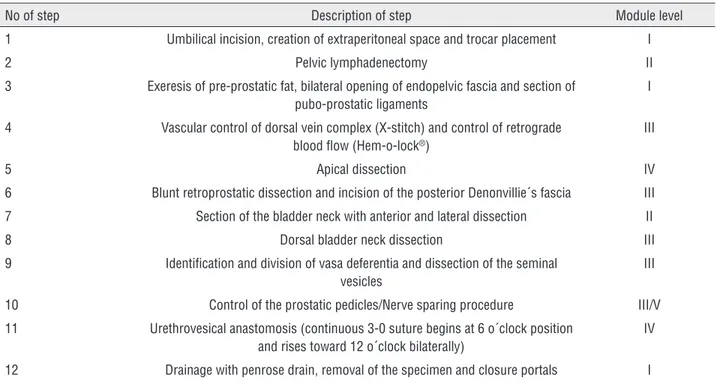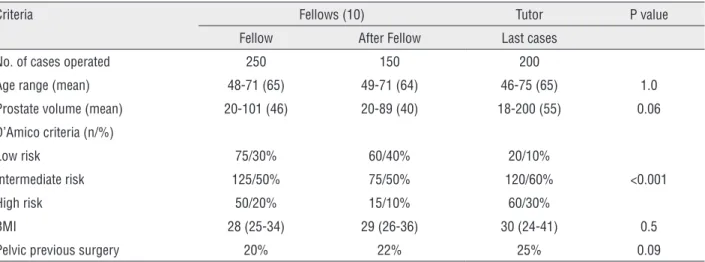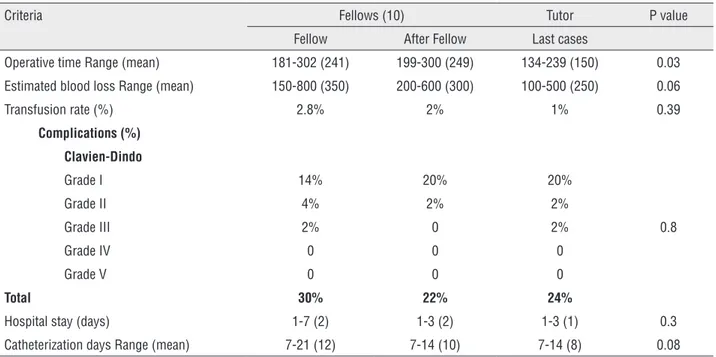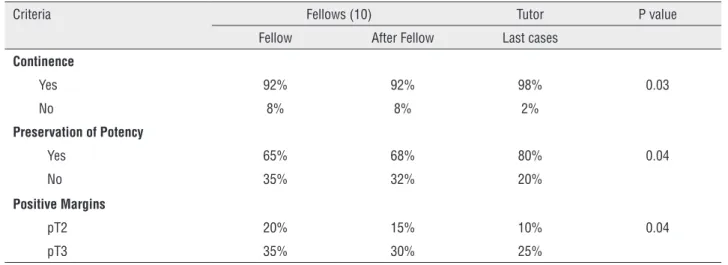A safe teaching protocol of LRP (Laparoscopic Radical
Prostatectomy)
_______________________________________________
Marcos Tobias-Machado
1, Cristiano Linck Pazeto
1, Oseas Castro Neves-Neto
1, Igor Nunes-Silva
2, Hamilton
de Campos Zampolli
21 Departamento de Urologia, Faculdade de Medicina ABC, Santo André, SP, Brasil; 2 Instituto do Câncer Arnaldo Vieira de Carvalho – IAVC , São Paulo, SP, Brasil
ABSTRACT
ARTICLE
INFO
______________________________________________________________ ______________________
Purpose: The LRP has a steep learning curve to obtain proficiency during which patient safety may be compromised. We present an adapted modular training system which purpose to optimize the learning curve and perform a safe surgery.
Materials and Methods: A retrospective analysis of the LRP safe learning protocol ap-plied during a fellowship program over eight years (2008-2015).
The surgery was divided in 12 steps and 5 levels of difficulty. A maximum time interval was stipulated in 240 minutes. After an adaptation, the fellows had 120 minutes to per-form all the corresponding modules to its accumulated skill. The participants gradually and safely pass through the steps and difficulty levels. Surgeries performed by fellows were analyzed as a single group and compared to a prior series performed by tutor.
Results: In eight years, 250 LRP were performed (25 per apprentice) during fellowship program and 150 procedures after completion. The baseline characteristics were com-parable. Most cases operated were of intermediate risk. Mean operative time was longer in the fellow group when compared to the tutor (150 min). Mean estimated blood loss were similar among the groups. Functional and oncological outcomes were better in the Tutor´s group. No conversion to open surgery was performed.
Conclusions: The LRP safe learning protocol proved to be an effective method to opti-mize the learning curve and perform safe surgery. However, the tutor’s functional and oncological results were better, showing that this is a procedure with a steep learning curve and proficiency demands more than 25 cases.
INTRODUCTION
Robot-assisted laparoscopic prostatectomy (RALP) is the standard procedure for minimally invasive prostate cancer treatment in several countries including US (1-3). This approach emer-ged as an evolution of laparoscopic radical pros-tatectomy (LRP). However, the high cost involved with this technology remains a huge obstacle to its expansion in developing countries. As
descri-bed previously, there are few units of da Vin-ci Surgical System (Intuitive Surgical, EUA) in Brazil. So, the number of people covered by this technology is very limited. Additionally, most of Brazilian urologists have not had access to RALP to become proficient in this method.
In this context, with an increasing and inexorable trend to perform minimally invasive techniques, the LRP appears as an alternative that seems important to keep teaching. The LRP
Keywords:
Prostatectomy; Education; Surgical Procedures, Operative
Int Braz J Urol. 2017; 43: 273-9
_____________________
Submitted for publication: March 06, 2017
_____________________
Accepted after revision: June 08, 2017
_____________________
provides improved visualization of the prostatic anatomy, accurate dissection, decrease in length of hospital stay and lower blood loss, comparing to open approach. However, it is one of the most technically demanding procedures in Urology (4). Some aspects inherent of laparoscopy such as two-dimensional images, decreased tactile sensation and limited range of motion can explain its difficulty. Besides, the abilities required to LRP differs from those of open surgery and attempts to transfer skills are not effective. Thereby, there is a long learning curve that has limited its expansion.
some procedures may last too long, (es-pecially when not assisted by experienced urolo-gists) thus subjecting the patient to serious risks associated with positioning and pneumoperito-neum (5). For example Schuessler and colleagues first series reported lengthy operative duration (8 to 11 hours) and too long hospital stay (average 7.3 days) (6).
Thus, to optimize the learning curve and perform safe surgery, we present an adapted mo-dular training system for fellows. The purpose is allowing a safe and optimal learning process divi-ding the steps of surgery by level of difficulty. The
results and the effects of this model in the learning curve will be accessed and compared to the tutor performance.
MATERIALS AND METHODS
This is a retrospective analysis of a LRP safe learning protocol. The 5-6 port LRP were per-formed during a 1-yr fellowship program in a Bra-zilian referral hospital. There were 10 fellows over a period of eight years (2008-2015).
The technique performed in the modular training was anterograde endoscopic extraperi-toneal radical prostatectomy (Table-1). Based on previous study of Stolzenburg et al. (7), we divide the surgery in 12 steps on which were assigned levels of difficulty from 1 to 5, being 5 the most difficult.
All study participants were graduated uro-logists with prior experience in laparoscopic pro-cedures (e.g.: nephrectomy, pyeloplasty) that did not include, however, pelvic procedures. When en-tering the program, all participants received trai-ning in dry-lab, including laparoscopic suturing techniques. The first 5 procedures were performed
Table 1 - Steps of modular training.
No of step Description of step Module level
1 Umbilical incision, creation of extraperitoneal space and trocar placement I
2 Pelvic lymphadenectomy II
3 Exeresis of pre-prostatic fat, bilateral opening of endopelvic fascia and section of pubo-prostatic ligaments
I
4 Vascular control of dorsal vein complex (X-stitch) and control of retrograde blood flow (Hem-o-lock®)
III
5 Apical dissection IV
6 Blunt retroprostatic dissection and incision of the posterior Denonvillie´s fascia III
7 Section of the bladder neck with anterior and lateral dissection II
8 Dorsal bladder neck dissection III
9 Identification and division of vasa deferentia and dissection of the seminal vesicles
III
10 Control of the prostatic pedicles/Nerve sparing procedure III/V
11 Urethrovesical anastomosis (continuous 3-0 suture begins at 6 o´clock position and rises toward 12 o´clock bilaterally)
IV
by the tutor with assistance from two fellows (one as holder camera and the other as first assistant). After this initial period, the tutor began to assist the trainees.
The tutor participated in all the procedures performed. A maximum time interval for surgery was stipulate in 240 minutes. Within this time, the trainees had 120 minutes to perform all the cor-responding modules to its accumulated skill and at least, try those there are more complex. This initially settled time could have been subjectively extended if surgery was advancing properly. Ho-wever, in case of no progression of the procedure, the tutor returns to assume. During the following operations, the fellows gradually and safely pas-sed through steps. In the end of the training, par-ticipants could try to perform the entire procedure within the recommended time. There was no case selection. The neurovascular bundles preservation was considered the most difficult step (level V).
The cases operated by the fellows were analyzed as a single group and compared to a prior series of 200 cases performed by the tutor (8). The number of procedures per fellow was the same to reduce the skill bias and homogenize the sample. Additionally, the results obtained in the post fellow set were included in this analysis as a third group.
The mean operating time, transfusion rate, intraoperative complications, length of hospi-tal stay, and positive surgical margins rates were analyzed. Clinical evaluation and PSA dosages
were done at 45 days after surgery and every three months over first two years to assess functional and oncological outcomes.
Urinary continence was defined as 0-1 pads/day at 12 months of follow-up. Potency status was evaluated through the question 5 of the IIEF (ability to maintain penile rigidity and erection sufficient for intercourse). All detected postoperative complications were graded in Cla-vien-Dindo Classification (9). Continues variables were compared by paired t-test, while categorical variables were analyzed by chi-square test. The confidence interval was 95 % (p<0.05) for statis-tical significance. Informed consents were obtai-ned by all patients and the study has been au-thorized by appropriate ethics committee (CAAE: 61327016.4.0000.0082).
RESULTS
In eight years of study (2008-2015), the first 25 LRP of each fellow were included (totaling 250 procedures during the program). Also, the first 150 procedures after fellow were accounted (as inde-pendent practice). There was no difference between mean age, BMI and pelvic previous surgeries among the three groups (Table 2). Mean prostate volume in tutor and fellow group was 55g (18-200) and 46g (20-101), respectively (p=0.06). Most of patients were classified as intermediate-risk group (60% vs. 50%, respectively for tutor and fellows). A higher
Table 2 - Demographic data of our patients that underwent LRP comparing fellows during and after fellowship and expert results.
Criteria Fellows (10) Tutor P value
Fellow After Fellow Last cases
No. of cases operated 250 150 200
Age range (mean) 48-71 (65) 49-71 (64) 46-75 (65) 1.0
Prostate volume (mean) 20-101 (46) 20-89 (40) 18-200 (55) 0.06
D’Amico criteria (n/%)
Low risk 75/30% 60/40% 20/10%
Intermediate risk 125/50% 75/50% 120/60% <0.001
High risk 50/20% 15/10% 60/30%
BMI 28 (25-34) 29 (26-36) 30 (24-41) 0.5
percentage of high-risk cases was found in the tutor group (p <0.001).
Mean operative time (OT) was longer in the fellow group (241 min) and post- fellowship (249 min) compared to the tutor (150 min; p=0.03). Mean estimated blood loss was 350 ml (range 150-800) for the fellows, 300ml (range 200-600) for post- fellowship and 250ml (range 100-500) for the tutor. Transfusion rates were similar between groups (2.8% vs 2% vs 1%; p=0.39). There were no grades IV and V complications and most were classified as grade I (Clavien-Dindo). Mean hospital length of stay was 2 days both for the fellow and for post- fellowship groups (range 1-7 and 1-3, respectively) and 1 day (range 1-3) for the tutor. Mean catheterization time was 12 days in the fellow group, 10 days in post--fellowship and 8 days in the tutor series (Table 3).
There were higher rates of continence (92% versus 98%, p=0.03) and potency (65% versus 80%, p=0.04) in the Tutor´s group. The positive margin rate for pT2 was 20%, 15% and 10% and for pT3 was 35%, 30% and 25% among those groups, res-pectively (p=0.04). No conversion to open surgery was required (Table 4).
DISCUSSION
The main objective of LRP safe learning protocol was fully achieved: there was a safe transfer of LRP skills during the fellowship pe-riod. The rate of perioperative complications was similar between the groups. There were no serious complications, deaths or conversions in all stages of the learning curve which reinforces the impor-tance of this method.
The OT of the fellows group was higher, but the average time was less than 4 hours (the longest lasted about 5 hours). This relatively short time during the learning period reduces signifi-cantly the risks of metabolic complications asso-ciated with the surgical procedure and keeps pa-tient safe.
There was a larger number of high risk pa-tients in tutor group; however, when these high--risk cases were operated by fellows, the surgery proceeded without any significant complications. Prostate weight was comparable between groups and this is an important detail, since large glan-ds decrease the visualization of the surgical field when performing the laparoscopic approach (10).
Table 3 - Perioperative data comparing fellows during and after the fellowship period and tutor results.
Criteria Fellows (10) Tutor P value
Fellow After Fellow Last cases
Operative time Range (mean) 181-302 (241) 199-300 (249) 134-239 (150) 0.03
Estimated blood loss Range (mean) 150-800 (350) 200-600 (300) 100-500 (250) 0.06
Transfusion rate (%) 2.8% 2% 1% 0.39
Complications (%)
Clavien-Dindo
Grade I 14% 20% 20%
Grade II 4% 2% 2%
Grade III 2% 0 2% 0.8
Grade IV 0 0 0
Grade V 0 0 0
Total 30% 22% 24%
Hospital stay (days) 1-7 (2) 1-3 (2) 1-3 (1) 0.3
We detected a trend of higher transfu-sion rates in fellow group, although the estima-ted blood loss was similar. This occurred because the major bleedings, though few, occurred in this group. The explanation is the greater difficulty in controlling the prostate venous plexus and longer operative times. Still, these outcomes are accepta-ble and similar to other studies with a mentored fellowship program (7, 11-14).
Studies demonstrating decreased le-arning curve from a mentored lele-arning model of LRP have been published since 2003 (11). In 2006, Stolzemburg and colleagues created the Leipzig method for learners without any expe-rience and reached satisfactory results (9). In 2013, these authors presented the five year’s follow-up with good oncologic outcomes (12). Therefore, modulated learning of LRP has pro-ven to be effective in achieving reasonable early and midterm outcomes (7, 15). However, there are several reports of failure of other teaching methods (courses and shorter programs) to in-corporate LRP in urologists practice (16).
One of the biggest challenges of this sur-gery is achieving negative surgical margins status with functional preservation. There is not only a learning curve but multiple curves for different variables. Although the primary goal was not the evaluation of our functional and oncological ou-tcomes, the expert’s results were better. These
be-cause the LC for these criteria was not met by the learners. According to theliterature, LC for onco-logical outcomes reaches plateau at approximately 200 to 250 cases (17, 18) and the number of cases required to achieve proficiency ranges from 200 to 700 (19). The 25 cases operated by apprentice did not allow them to reach proficiency in these aspects. Nevertheless, this protocol presents a safe and effective learning method.
Regarding surgical steps, a previous study compared systematically the single steps of LRP with those of open approach. Although the anas-tomosis time decreased over time, it was conside-red the hardest and most demanding surgical step and its difficulty score remained high and stable (20). In our study, it was remarkable the difference in achieving proficiency in steps as Retzius access space, division of dorsal vein complex and dissec-tion of seminal vesicles when compared to most difficult ones: preservation of neurovascular bun-dles and urethrovesical anastomosis. The choice of a bilateral continuous 3-0 monocryl suture to perform the vesicourethral anastomosis (Van Vel-thoven) improved results.
Finally, Another benefit of a LRP teaching model in a resident program was previous highli-ghted: even technically more demanding, there is a limited risk of mortality due to bleeding as in a kidney ablative surgery. Because of that, it could be a better model than nephrectomy to advance in laparoscopy training.
Table 4 - Oncological and Functional outcomes.
Criteria Fellows (10) Tutor P value
Fellow After Fellow Last cases
Continence
Yes 92% 92% 98% 0.03
No 8% 8% 2%
Preservation of Potency
Yes 65% 68% 80% 0.04
No 35% 32% 20%
Positive Margins
pT2 20% 15% 10% 0.04
As a future perspective, previous publi-shed data demonstrated that experienced surgeons in laparoscopy can maintain their oncological and functional results even in the LC of RALP (21, 22). Although the RALP has overcame the LRP func-tional outcomes, we believe that in developing countries, such as Brazil, there´s a relevant role to LRP, yet. Also, the transition to RALP will be helped by minimally invasive skills acquired.
The limitations of this study were its re-trospective nature, small number of patients, the absence of mid and late oncological outcomes and temporal distance between tutor and fellow’s se-ries. However, it has achieved the central purpose assessing the feasibility and safety of this learning method.
CONCLUSIONS
The LRP safe learning protocol proved to be an effective method to optimize the lear-ning curve and perform safe surgery. However, the tutor’s functional and oncological results were better, showing that this is a procedure with a ste-ep learning curve and proficiency demands more than 25 cases.
ABBREVIATIONS
LC = Learning Curve
LRP = Laparoscopic radical prostatectomy RALP = Robot-assisted laparoscopic prostatec-tomy
OT = Operative time
IIEF = International Index of Erectile Function
CONFLICT OF INTEREST
None declared.
REFERENCES
1. Ficarra V, Cavalleri S, Novara G, Aragona M, Artibani W. Evidence from robot-assisted laparoscopic radical prostatectomy: a systematic review. Eur Urol. 2007;51:45-55; discussion 56.
2. Davison BJ, Matthew A, Gardner AM. Prospective comparison of the impact of robotic-assisted laparoscopic radical prostatectomy versus open radical prostatectomy on
health-related quality of life and decision regret. Can Urol Assoc J. 2014;8(1-2):E68-72.
3. Papachristos A, Basto M, Te Marvelde L, Moon D. Laparoscopic versus robotic-assisted radical prostatectomy: an Australian single-surgeon series. ANZ J Surg. 2015;85:154-8.
4. Guillonneau B, Rozet F, Barret E, Cathelineau X, Vallancien G. Laparoscopic radical prostatectomy: assessment after 240 procedures. Urol Clin North Am. 2001;28:189-202.
5. Meininger D, Byhahn C, Wolfram M, Mierdl S, Kessler P, Westphal K. Prolonged intraperitoneal versus extraperitoneal insufflation of carbon dioxide in patients undergoing totally endoscopic robot-assisted radical prostatectomy. Surg Endosc. 2004;18:829-33.
6. Schuessler WW, Schulam PG, Clayman RV, Kavoussi LR. Laparoscopic radical prostatectomy: initial short-term experience. Urology. 1997;50:854-7.
7. Stolzenburg JU, Rabenalt R, Do M, Horn LC, Liatsikos EN. Modular training for residents with no prior experience with open pelvic surgery in endoscopic extraperitoneal radical prostatectomy. Eur Urol. 2006;49:491-8;499-500.
8. Starling ES, Reis LO, Vaz Juliano R, Korkes F, Wanderlei Dos Santos M Jr, Lima Pompeo AC, et al. Extraperitoneal endoscopic radical prostatectomy: How steep is the learning curve? Overheads on the personal evolution technique in 5-years experience. Actas Urol Esp. 2010;34:598-602. 9. Dindo D, Demartines N, Clavien PA. Classification of
surgical complications: a new proposal with evaluation in a cohort of 6336 patients and results of a survey. Ann Surg. 2004;240:205-13.
10. Pettus JA, Masterson T, Sokol A, Cronin AM, Savage C, Sandhu JS, et al. Prostate size is associated with surgical difficulty but not functional outcome at 1 year after radical prostatectomy. J Urol. 2009;182:949-55.
11. Ramírez Backhaus M, Uwe Stolzenburg J, Do M, Dietel A, Ruiz-Cerdá JL, Jiménez Cruz JF. Learning laparoscopic radical prostatectomy with the Leipzig program. Analysis of the training module program. Actas Urol Esp. 2009;33:290-5.
12. Fabrizio MD, Tuerk I, Schellhammer PF. Laparoscopic radical prostatectomy: decreasing the learning curve using a mentor initiated approach. J Urol. 2003;169:2063-5.
13. Skrekas T, Mochtar CA, Lagerveld BW, de Reijke TM, van Velthoven RF, Peltier A, et al. Mentor-initiated approach in laparoscopic radical prostatectomy. J Endourol. 2006;20:831-5.
14. Raventós Busquets CX, Cecchini Rosell L, Trilla Herrera E, Planas Morin J, Orsola de los Santos A, Morote Robles J. [Laparoscopic radical prostatectomy: learning curve with a mentor training program]. Actas Urol Esp. 2007;31:205-10. 15. Good DW, McNeill SA, Stewart GD, Stolzenburg JU. 922
benefits of a mentored fellowship programme. Eur Urol Suppl 2013;12:e922–3.
16. Brown JA, Sajadi KP. Laparoscopic radical prostatectomy: six months of fellowship training doesn’t prevent the learning curve when incorporating into a lower volume practice. Urol Oncol. 2009;27:144-8.
17. Secin FP, Savage C, Abbou C, de La Taille A, Salomon L, Rassweiler J, et al. The learning curve for laparoscopic radical prostatectomy: an international multicenter study. J Urol. 2010184:2291-6.
18. Martínez-Piñeiro L, Cáceres F, Sánchez C, Tabernero A, Cansino JR, Alonso S, et al. Learning Curve of Laparoscopic Radical Prostatectomy in a University Teaching Hospital: Experience after the First 600 Cases. Eur Urol Suppl 2006;5:914–24.
19. Sandhu GS, Nepple KG, Tanagho YS, Andriole GL. Laparoscopic prostatectomy for prostate cancer: continued role in urology. Surg Oncol Clin N Am. 2013;22:125-41, vii.
20. Poulakis V, Dillenburg W, Moeckel M, de Vries R, Witzsch U, Zumbé J, et al. Laparoscopic radical prostatectomy: prospective evaluation of the learning curve. Eur Urol.
2005;47:167-75.
21. Tobias-Machado M, Mitre AI, Rubinstein M, Costa EF, Hidaka AK. Robotic-assisted radical prostatectomy learning curve for experienced laparoscopic surgeons: does it really exist? Int Braz J Urol. 2016;42:83-9.
22. Pearce SM, Pariser JJ, Karrison T, Patel SG, Eggener SE. Comparison of Perioperative and Early Oncologic Outcomes between Open and Robotic Assisted Laparoscopic Prostatectomy in a Contemporary Population Based Cohort. J Urol. 2016;196:76-81.
_______________________ Correspondence address:
Cristiano Linck Pazeto, MD Departamento de Urologia, Faculdade de Medicina ABC



